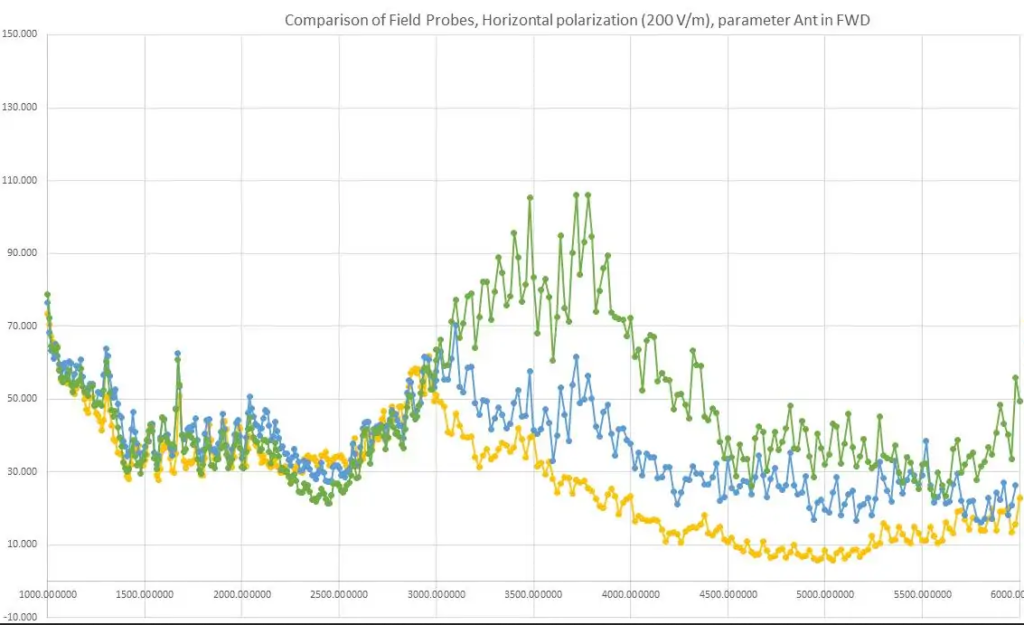Measurement Speed versus Measurement Accuracy: which is more important?
Accuracy goes before speed!
Measurement Speed versus Measurement Accuracy | Some manufacturers of E-field probes underline the factor speed. Although speed could be an important factor in some applications, accuracy comes first. In this article we concentrate on this topic.
Specifications of E-field probes
E-field probes are specified by several parameters, such as measuring range, frequency range, linearity, speed and (as was made clear in recent articles) isotropy. In practice, it turns out that isotropy is the main contributor to the overall measurement uncertainty. At the same time the influence of this parameter may be so large, that it practically renders the results unusable. This is a major concern as the E-field probe is the main instrument on which immunity testing relies, as it measures the absolute value of the radiated field. It is not only used to perform EMC immunity tests but is also the instrument used to verify that the anechoic chamber is acceptable when used during the 16-point UFA verification. It is important to note that the accuracy of the field probe influences the accuracy of the test in two ways!
Why speed?
Why is speed put forward as an important parameter? This is a good question as EMC measurements in anechoic chambers are relatively slow, considering that typically dwell times of 2 seconds per test frequency are used. Typically, field probe measurement speeds of 50 samples per second will not decrease the overall measurement speed significantly. So why the need for a higher speed?
Some applications such as military, automotive or aerospace, can make use of a mode-stir or reverberation chamber. Unlike anechoic chambers, absorbers do not cover the walls, ceiling and floor and there is no homogeneous area. Using this test method, there are many reflections reaching the probe from all directions in the chamber. This requires fast measurements from the E-field probe in order to establish a reliable average field at a certain point. Measurement speeds of up to 1,000 samples per second are common in these situations. Another application is the real time measurement of radar pulses. It is very true that in these applications, speed is an important factor.
So, speed or accuracy?
But what is the use of fast measurements when one cannot rely on the results? It is of no used to have a (extremely) fast probe when the results are (very) unreliable. The first focus should be on reliable and accurate results. When this is the case, then the focus may shift to speed
Measurement Speed versus Measurement Accuracy – Anecdote
Once there were two darts players. The first player was extremely efficient and was able to throw the three darts in 5 seconds. Unfortunately, none of the thrown darts hit the mark. The second player was much less efficient, and it took him 15 seconds to throw the three darts. However, they all three hit the mark! Which player would you prefer? So, effectively goes before efficiency or accuracy goes for speed! Once you always hit the mark, you can try to improve the efficiency, not the other way around.
However logically this may sound, in the EMC arena the focus appears to concentrate on speed without asking the question ‘are we achieving accurate results?’. This seems especially the case with e-field probes. Manufactures proudly present impressive measurement speeds but fail to correctly specify the isotropic behaviour, although this parameter has a decisive impact on the accuracy. The graph below clearly shows the current situation where at 50 V/m field strength, with field probes from different manufacturers in the same anechoic chamber, produce results varying between 25 and 105 V/m.

Some quality food for thought
With this evidence it is obvious that measurements, or 16-point UFA calibrations, performed with these kinds of inaccuracies are useless. Even if the measurement speed is thousands of measurements per second, if the measured values are somewhere in a range this broad, then who cares about the speed?
Users of mode stir chambers and measuring radar pulses will say that speed is very important to them. Clearly speed is an important factor here, but the question must be ‘is it more important than accuracy?’ Certainly, in mode stir chambers, reflections play an important role, and in fact it is all about reflections! However, this puts extra pressure on the isotropic behaviour of the E-field probe. In these chambers, the reflections at different field strength will arrive at the probe at the same time, and from all different angles. In this case, non-isotropic behaviour of the probe will produce even worse results!
With Radar applications requires speed but isotropy is equally important. to measure the pulses a measurement device needs high speed. But what is the benefit of high-speed measurements if the results are inaccurate or even worse completely wrong? In mode stir testing and radar applications, the problems with isotropic behaviour of the probe must be solved before considering speed.
Conclusion
In all environments, whether in anechoic chambers or reverberation chambers, good isotropic behaviour of the field probe is paramount. There is no use for fast probes that produce unreliable and inaccurate results. This which paper can conclude that accuracy always goes before speed.

